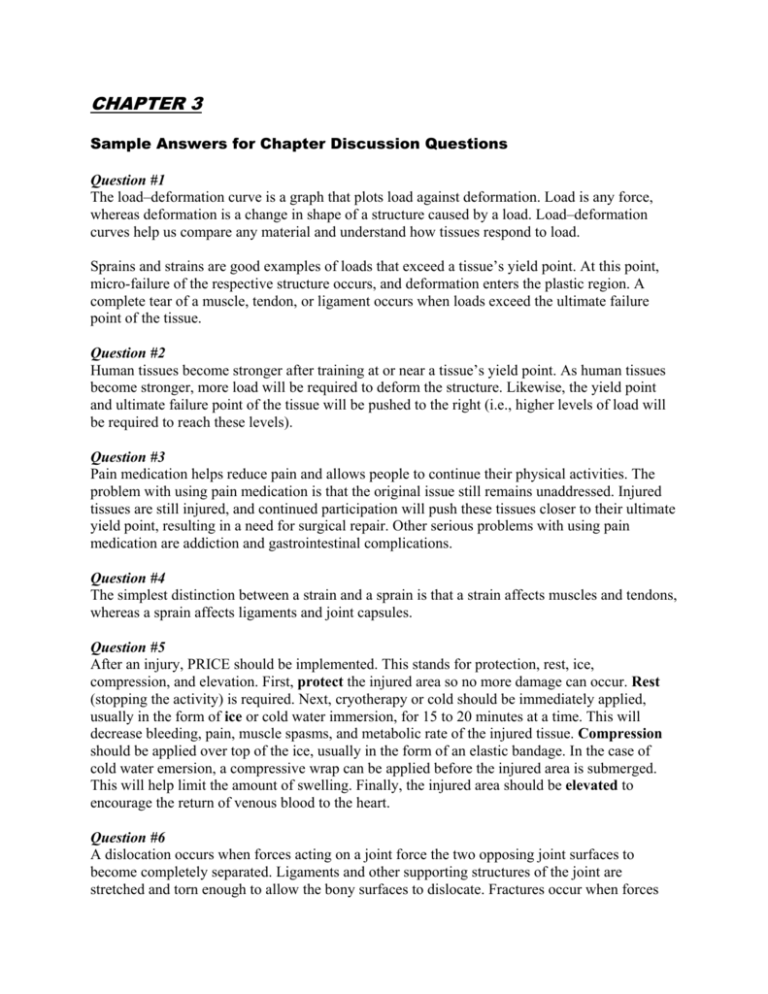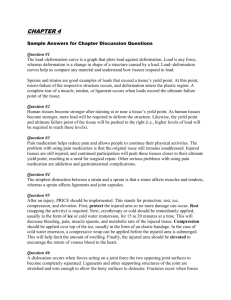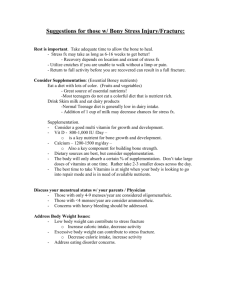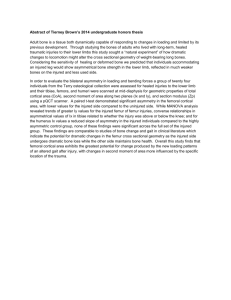chapter 3
advertisement

CHAPTER 3 Sample Answers for Chapter Discussion Questions Question #1 The load–deformation curve is a graph that plots load against deformation. Load is any force, whereas deformation is a change in shape of a structure caused by a load. Load–deformation curves help us compare any material and understand how tissues respond to load. Sprains and strains are good examples of loads that exceed a tissue’s yield point. At this point, micro-failure of the respective structure occurs, and deformation enters the plastic region. A complete tear of a muscle, tendon, or ligament occurs when loads exceed the ultimate failure point of the tissue. Question #2 Human tissues become stronger after training at or near a tissue’s yield point. As human tissues become stronger, more load will be required to deform the structure. Likewise, the yield point and ultimate failure point of the tissue will be pushed to the right (i.e., higher levels of load will be required to reach these levels). Question #3 Pain medication helps reduce pain and allows people to continue their physical activities. The problem with using pain medication is that the original issue still remains unaddressed. Injured tissues are still injured, and continued participation will push these tissues closer to their ultimate yield point, resulting in a need for surgical repair. Other serious problems with using pain medication are addiction and gastrointestinal complications. Question #4 The simplest distinction between a strain and a sprain is that a strain affects muscles and tendons, whereas a sprain affects ligaments and joint capsules. Question #5 After an injury, PRICE should be implemented. This stands for protection, rest, ice, compression, and elevation. First, protect the injured area so no more damage can occur. Rest (stopping the activity) is required. Next, cryotherapy or cold should be immediately applied, usually in the form of ice or cold water immersion, for 15 to 20 minutes at a time. This will decrease bleeding, pain, muscle spasms, and metabolic rate of the injured tissue. Compression should be applied over top of the ice, usually in the form of an elastic bandage. In the case of cold water emersion, a compressive wrap can be applied before the injured area is submerged. This will help limit the amount of swelling. Finally, the injured area should be elevated to encourage the return of venous blood to the heart. Question #6 A dislocation occurs when forces acting on a joint force the two opposing joint surfaces to become completely separated. Ligaments and other supporting structures of the joint are stretched and torn enough to allow the bony surfaces to dislocate. Fractures occur when forces acting on bone exceed the ultimate yield point. Therefore the main difference is the tissue that is involved. Each of these tissues will have unique biomechanical properties that define loads required to cause injury, whether dislocation or fracture. Question #7 Lateral epicondylitis, commonly known as tennis elbow, affects tendons of the forearm extensor/supinator muscles. These muscles attach to the lateral epicondyle of the humerus. People who play tennis or other racket sports may develop this problem. Medial epicondylitis, commonly known as golfer’s elbow, is similar to tennis elbow but it occurs on the inner side. This condition affects the tendons of the forearm flexors/pronators, which attach to the medial epicondyle of the humerus. Medial epicondylitis affecting the medial humeral growth plate in young children or adolescents is called little league elbow. Patellar tendonitis or jumper’s knee is caused by repetitive eccentric knee actions, such as jumping in volleyball, basketball, and track and field events. It affects the infrapatellar ligament of the knee. Question #8 Both tendonitis and bursitis are inflammatory processes, but the difference lies in the anatomical structure that is inflamed. Although both result from overuse and stress, tendonitis is an inflammation of a tendon, while bursitis is an inflammation of a bursa. Question #9 A stress fracture begins as a small disruption in the continuity of the outer layers of cortical bone. With continued stress to the weakened bone, complete cortical bone fracture can occur. Shin splints describe pain that occurs along the inner surface of the tibia, without a disruption of the cortical bone. X-rays and possibly bone scans are therefore needed to properly diagnose a stress fracture. Question #10 Warming up helps an athlete prepare optimally (physically and mentally) for a competition or workout. Most research advocates a thorough and well-planned warm-up to not only improve performance but also to help prevent injury. Cooling down helps remove lactic acid and other products of metabolism from the muscles and tissues, reducing some of the stiffness and tightness that is often felt the next day. The cardiovascular system may also benefit from a gradual cool-down period since the abrupt lowering of an elevated heart rate is not ideal. Question Bank for Written Student Assessment and Evaluation Quiz: How Much Do You Know About Sports Injuries? 1. Which of the following statements about the load–deformation curve is false: A) The A-B segment of the curve represents the elastic region of the tissue structure. B) The B-C segment of the curve represents the strength of the material in terms of stored energy. C) Loads occurring in the elastic region do not cause permanent damage. D) Permanent deformation will occur if the load exceeds a certain point. E) None of the above. Answer: B 2. In the _________ region of the load–deformation curve, a tissue returns to its original shape after a load is removed. Answer: elastic 3. When training loads are at or near a tissue’s ultimate yield point, cells may divide to make new cells or to make proteins. Answer: false (Correct: yield-level point) 4. Which of the following statements about the fibroblastic repair phase is true: A) It is the third phase of healing. B) It may last as long as three weeks. C) It begins around 24 hours after injury. D) It leads to scar formation. E) Two of the above. Answer: D 5. When a compression force crushes tissue, a _________ results. Answer: contusion or bruise 6. Regular use of certain medications to decrease pain and inflammation may be helpful and appropriate. Answer: false (Correct: Temporary) 7. Abnormal bone formation resulting from a severe contusion to a soft tissue is called: A) a charleyhorse B) jumper’s knee C) myositis ossificans D) a subluxation E) a bone spur Answer: C 8. When a ligament or the joint capsule is stretched or torn, the injury is called a _________. Answer: sprain 9. Another common term for a complete dislocation is subluxation. Answer: false (Correct: partial) 10. Which of the following statements about dislocation of the shoulder is true: A) It most commonly occurs when the head of the humerus slips posteriorly. B) A common mechanism of injury is falling backwards and landing on a flexed arm. C) It can result in injury to the brachial plexus. D) It is an example of an overuse injury. E) None of the above. Answer: C 11. _________ fractures occur when a tendon or ligament pulls a small chip of bone away from the rest of the bone. Answer: Avulsion 12. Neurosurgeons and other brain experts state that minor concussions sometimes occur. Answer: false (Correct: never) 13. Which of the following is not an overuse injury: A) shoulder impingement B) tendonitis C) stress fracture D) bursitis E) none of the above Answer: E 14. Tiny fluid-filled sacs that lubricate and cushion pressure points between your bones and tendons are called _________. Answer: bursae 15. Not cooling down after a workout can lead to muscle atrophy. Answer: false (Correct: stiffness or tightness) 16. Explain the steps involved in the PRICE rule when dealing with an injury. Answer: Protect the injury from further damage, rest the injury (i.e., stop exercising), apply ice to the injury, compress the injury with a bandage, and elevate the injury site above the heart. Multiple Choice Questions 1. The elastic region turns into the plastic region at the A) elastic limit B) yield-level point C) ultimate yield point D) ultimate failure point E) two of the above Answer: E (A and B) 2. A bone fracture or a torn ligament occurs _________ of the load–deformation curve. A) at the elastic limit B) in the plastic region C) at the yield-level point D) at the ultimate yield level E) two of the above Answer: E (B and D) 3. The maturation–remodeling phase: A) is a long-term process of realigning the scar tissue B) begins about six weeks after injury C) may continue for as long as several years D) all of the above E) two of the above Answer: E (A and C) 4. “Charleyhorse” is a common name for a: A) tibial stress fracture B) contusion to the quadriceps C) hamstring strain D) hamstring sprain E) none of the above Answer: B 5. In a grade three sprain, A) there is severe pain during passive movements B) there is severe pain during isometric and passive movements C) there is moderate pain during passive movements D) there is moderate pain during isometric and passive movements E) there is no pain during isometric and passive movements Answer: E 6. Which of the knee stabilizing ligaments is more commonly torn: A) anterior cruciate ligament B) posterior cruciate ligament C) medial collateral ligament D) lateral collateral ligament E) all are equally likely to tear Answer: A 7. Which of the following statements about ankle sprains is false: A) Ankle sprains are among the most common athletic injuries. B) Symptoms include rapid swelling and point tenderness. C) Ankle sprains most commonly occur in the medial ligaments. D) Balance exercises can help prevent possible future injuries. E) None of the above. Answer: C 8. Which type of fracture typically occurs in children and involves explosive throwing and jumping movements: A) stress B) avulsion C) spiral D) compound E) comminuted Answer: B 9. Which of the following statements about concussions is false: A) They develop from a violent shaking or jarring action of the head. B) They occur most often in organized sports. C) They may result from a whiplash effect to the neck. D) They lead to temporary loss of normal brain function. E) They are caused by the brain bouncing against the inside of the skull. Answer: B 10. Little league elbow: A) occurs at the lateral epicondyle B) affects the humeral growth plate C) often results from excessive forces required to throw curveballs D) all of the above E) two of the above Answer: E (B and C) 11. Which of the following statements regarding shoulder impingement is false: A) It results in inflammation in the bursae or rotator cuff tendons. B) Muscle imbalances in the shoulder are largely responsible for its development. C) Lack of space between the humeral head and the collarbone is one of the causal factors. D) None of the above. E) Two of the above. Answer: C 12. Stress fractures: A) result from repeated high-magnitude forces B) begin as a small disruption in the continuity of the inner layers of the cortical bone C) occur often in the metatarsals D) are also known as shin splints E) all of the above Answer: C 13. Which of the following is not a strategy for preventing shin splints: A) Limit running on uneven surfaces. B) Join a running club. C) Address muscle imbalances. D) Stay hydrated. E) None of the above. Answer: A 14. Which of the following is not a strategy for injury prevention in sport: A) Use protective equipment. B) Warm up and cool down. C) Keep fit and flexible during the off-season. D) Eat well and get plenty of rest. E) None of the above. Answer: E 15. Which of the following statements about off-season training is false: A) Sometimes the most important gains are made in the off-season. B) The off-season is a time to develop and refine technical skills. C) The off-season is a time to maintain physical fitness. D) Not training during the off-season can lead to preseason injuries. E) None of the above. Answer: E Fill in the Blank Questions 1. The four basic types of tissue are _________, _________, _________, and _________. Answer: epithelial; muscle; connective; nervous 2. The resistance to deformation is known as _________. Answer: stiffness 3. _________ is the capacity of a tissue to return to its original shape after a load is removed. Answer: Elasticity 4. During _________, a patient receives care by a health care professional. A therapist’s physical restoration of the injured tissue along with the patient’s active participation is known as _________. Answer: treatment; rehabilitation 5. Ice or cold water immersion is known as _________. Answer: cryotherapy 6. In the second phase of healing, a delicate connective tissue called _________ tissue forms to fill the gaps in the injured area. Answer: granulation 7. When muscle or tendon tissue is stretched or torn, the injury is called a _________. Answer: strain 8. The most commonly strained muscles in the body are the _________. Answer: hamstrings 9. Research indicates that the main reason why ankle sprains reoccur is decreased _________ following the initial sprain. Answer: proprioception 10. _________ fractures stay within the surrounding soft tissue, whereas _________ fractures protrude from the skin. Answer: Simple; compound 11. Overuse injuries are caused by excessive _________ movements. Answer: repetitive 12. People who play tennis are most likely to develop _________ epicondylitis. Answer: lateral 13. Patellar tendonitis is commonly known as _________. Answer: jumper’s knee True or False Questions 1. Skin is an example of connective tissue. Answer: false (Correct: epithelial) 2. A prosthesis cannot handle loads as well as the human tissue it replaces. Answer: false (Correct: can) 3. Sprains and strains occur in the elastic region of the load–deformation curve. Answer: false (Correct: plastic region) 4. The slope of the curve in the elastic region indicates the stiffness of the material. Answer: true 5. Tissue becomes completely unresponsive to loads at the yield-level point. Answer: false (Correct: ultimate yield point) 6. The inflammatory response phase lasts from two to four days. Answer: true 7. Fibroblasts produce collagen fibers, which are deposited randomly throughout the forming scar. Answer: true 8. During the maturation–remodeling phase, it is important to introduce controlled rehab-specific exercises that are designed to restore normal range of motion and strength to the injured tissue. Answer: false (Correct: fibroblastic repair) 9. Sprains and strains are classified into three grades based on the amount of damage to the tissue and the resulting pain and loss of function. Answer: true 10. Grade one sprains are the most serious. Answer: false (Correct: three) 11. The main mechanism of a hamstring injury is rapid contraction in a shortened condition. Answer: false (Correct: lengthened) 12. The shoulder joint is the most mobile joint and the least unstable. Answer: true; false (Correct: most) 13. Simple fractures result from repeated low-magnitude training loads. Answer: Stress 14. Helmets should be replaced after they have sustained several significant impacts. Answer: false (Correct: one significant impact) 15. Medial epicondylitis is commonly known as golfer’s elbow. Answer: true 16. Research indicates that a proper warm-up can improve performance. Answer: true 17. Some studies have shown that strength can be maintained with as little as one or two workouts a week at 90 percent of capacity. Answer: true Other Types of Questions 1. Draw a typical load deformation curve of a bone in the diagram below. Fill in the empty boxes with the correct terms. High C B Low Answer: A Small Large High Ultimate Yield Point C Yield-level Point Lo ad B Plastic Region Elastic Region Low A Small Large Deformation 2. Name the type of physical stress acting on the structure in each of the following figures. Answers are in italics. Tension Compression Bending Shear Torsion 3. Distinguish between treatment and rehabilitation. Answer: During treatment, a patient receives care by a health care professional. Early and correct treatment promotes the healing process and improves the quality of the injured tissue(s), allowing the person to return to activity more quickly. Rehabilitation involves a therapist’s physical restoration of the injured tissue along with the patient’s active participation by following prescribed rehabilitation guidelines on his or her own. 4. Name the three phases of healing. Indicate the duration and the major physiological process that occurs during each phase. Answers are in italics. Duration: 2 – 4 days Inflammatory response phase Physiological process: hours – 6 weeks 3 weeks – years Fibroblastic repair phase Inflammation Maturation– remodeling Repair and scar formation Realigning of scar tissue 5. Complete the following table on sprains and strains. Answers are in italics. Symptoms Several muscle fibers have been stretched or torn. There is decreased range of motion and moderate loss of function. Ligament is torn. There is no pain during isometric and passive movements. A few muscle fibers have been stretched or torn. There is minor weakness and swelling. Sprain or strain? Strain 1st, 2nd, or 3rd degree? 2nd Sprain 3rd Strain 1st 6. Distinguish between four different types of fractures. Answer: Simple fracture: bone stays within the surrounding soft tissue Compound fracture: bone protrudes from the skin Stress fracture: results from repeated low-magnitude training loads and results in disruption of the outer layers of cortical bone Avulsion fracture: involves a tendon or ligament pulling a small chip of bone away from the rest of the bone 7. Outline how to prevent shin splints. Answer: * Limit running on hard surfaces. Running on a variety of surfaces will force your supporting leg muscles to strengthen. * Join a running club. Increasing mileage too quickly places excessive stress on the tibia. Proper training programs and technique are important. * Seek medical treatment. If you experience symptoms, seek medical attention to prevent future problems. * Address muscle imbalances. Tight calf muscles and weak tibialis anterior muscles can decrease your ability to absorb forces. * Αvoid biomechanical misalignment. Anything from your toes to your head can affect the way you run. * Wear proper well-cushioned shoes. Shoes that are worn or that don’t fit properly should be replaced. Running shoes should be used for running, not basketball or tennis shoes. * Stay hydrated. Water is a key lubricant that permits bones, muscles, and connective tissues to slide against each other. * Apply ice. Even if you do not feel discomfort after the activity it is important to ice. 8. What role do diet and rest play in preventing injury? Answer: Diet and rest play a major role in keeping the body well-tuned for injury prevention. In order to function most effectively, the body must be fed the proper nutrients and must receive adequate rest. Adhering to nutritional guidelines can prepare you for the stresses of physical exertion and lower your risk of sustaining an injury. Because training and competition involve putting forth great physical effort, muscles need rest from these physical demands to recuperate for the next training or competitive session. Muscles forced to endure heavy demands when inadequately rested may snap (literally) under pressure. Overtraining can be just as detrimental to your performance as not training enough. Inadequate sleep may also lead to mishaps that could have been avoided with proper rest and alertness.









